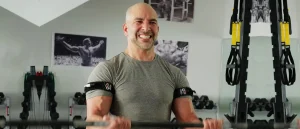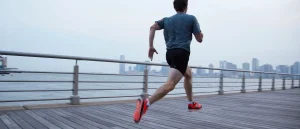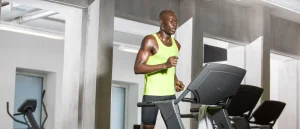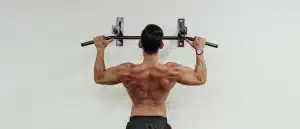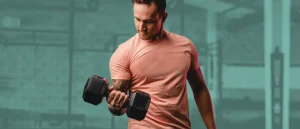Think You’re Too Fit to Call Walking a Workout? Try Rucking
If you’re decently fit, it can be hard to get your heart rate up from walking alone. That’s where running comes in. Except, running is high impact—which means if you’re trying to avoid overuse injuries, it’s not your best bet. Your move: Throw on a heavy backpack. Rucking, or walking with a weighted pack on your back, is a staple of military training that helps troops get (and stay) fighting fit. And you don’t need to be a Green Beret to reap the benefits.
According to Michael Easter, a rucking aficionado and writer who covers the art and science of improving human potential, we were born to carry. “Our ancestors carried often. It gave them robust functional strength and endurance that was likely very protective. But we’ve engineered carrying out of our lives, just as we have many other forms of discomfort. Rucking is a practical way to add carrying back in,” Easter wrote in his book The Comfort Crisis.
What is Rucking?
Rucking (aka ruck marching) is simply walking or hiking while carrying weight across distance. Usually, the load is carried in a “rucksack”—soldier-speak for a durable backpack designed for carrying heavy loads—and positioned on your back. You can get a designated rucksack, or just throw something heavy in any backpack and start walking.
Rucking takes the average person and toughens them—a stronger heart and muscles, and more resilient joints. It’s lower impact than running, and the extra weight dials up the intensity of a normal walk.
Benefits of Rucking
Rucking is associated with tons of unexpected (but very welcome) benefits. Here are the highlights.
It might help you live longer
According to leading longevity experts, both cardio and strength are essential for living a longer, healthier life. Most people’s fitness routines do really well at hitting one or the other, but they rarely succeed at both. Consider rucking the great equalizer. “Rucking is strength and cardio in one,” says Easter. It’s basically the ultimate metabolic workout, helping you shed fat and build muscle at the same time. It’ll make you look like an absolute machine and operate like one, too.
It builds functional strength
“Carrying weight across distance is something we totally missed the boat on in the fitness world, and rucking is the most accessible way to do that,” says Easter. Loading your back with a heavy pack transforms an ordinary walk into a strength exercise—working everything from your shoulders to your feet as an integrated system. This, in turn, improves your functional fitness, or your ability to complete daily activities with ease.
Since rucking strengthens your hips, calves, and shins unilaterally (or one side at a time), it’s the perfect low-impact cross-training workout for runners or cyclists. It also builds your aerobic capacity and core strength while reducing your risk of injuries.
It boosts cardiovascular fitness
Rucking takes an approachable exercise like walking and allows you to increase the strain on your heart incrementally, says Easter. The extra effort dials up your VO2 max—widely known as the best indicator of cardiovascular fitness. In fact, according to a study published in the Journal of Strength and Conditioning Research, healthy men saw significant improvements in VO2 max after following a 10-week rucking program (1).
It torches calories
For the average guy, a 30-minute walk burns around 125 calories, according to The Compendium of Physical Activities (2). Throw a weighted backpack on and that same walk rakes in 325 calories. It definitely depends on the weight you’re carrying and how fast you’re moving, though. Going faster with more weight will burn more calories.
It strengthens bones
While osteoporosis—a condition that causes bones to become weak and frail—is typically associated with women, men’s bone density is just as important. And it’s getting worse. 30 percent of all hip fractures occur in men, and mortality from any fracture is significantly higher in men than women (3).
The solve: Weight-bearing exercise. Any weight-bearing activity—like walking, running, or strength training—can help. However, “rucking seems to be particularly good for building bone density,” says Easter. It’s slightly higher impact than walking, but lower impact than running. It wins in the added resistance department, too.
It can improve your posture and prevent back pain
If your day is spent sitting in a hunched forward position, rucking can help. A rucksack naturally pulls your shoulders back—exactly how they should be with proper posture. This, in turn, shifts your spine into a more upright position, which can relieve the pain that accompanies the average desk slouch. Since rucking strengthens your postural muscles, you’ll have better posture when you aren’t rucking, too.
It’s accessible
“If you can walk, you can ruck,” says Easter. Better yet, it easily slips into the existing moments of your day. Whether you’re walking the dog, taking a work call outside, or cruising around the block after dinner, simply throw on a loaded backpack to immediately upgrade any activity.
It gets you outdoors
Let’s face it, most of us work inside all day. If going to the gym feels like a drag, try rucking. It gets you outside, walking in nature. “Rucking is time to unplug, clear your head, and sort through your thoughts,” says Easter. Studies have linked spending time outdoors with less stress and better cognitive function (4, 5).
That said, it doesn’t have to be outdoors. Easter’s done it on a cardio climber in the gym, and on a treadmill to reduce his risk of injury while quickly building his base for an extreme hunting trip in Alaska.
It’s social
Because each person can scale the weight to their fitness level, rucking is great for groups. “If you’re running with a group of people, you need everyone to be at the same fitness level to get a good workout, but with rucking you can have one person with a heavier pack, another with a lighter pack, or someone without one at all,” Easter says. Rucking allows you to get whatever you want out of your workout while keeping pace with the pack.
How to Start Rucking
Getting started is more simple than you think.
1. Gear up
“Just use any backpack you have and anything with some weight to it to get started,” says Easter. Textbooks, water bottles, or even bricks or dumbbells wrapped in towels qualify. A towel can help to stabilize and cushion your back from any awkward or uncomfortable shaped items, he adds.
Once you’re fully bought in (promise, you will be) then you can invest in the goods. “Use GORUCK gear, they make the best stuff,” says Easter. Bonus: they’re veteran-owned. His go-to rucksack is the GORUCK Rucker 4.0L which he loads up with GORUCK Ruck Plates.
2. Start light
In terms of weight, Easter recommends anywhere from 10 to 20 percent of your body weight. “Some people find that overwhelming, others underwhelming,” he says. “If you need to go lower, go for it. It all depends on your fitness level.” If you’re using odd items as weights, don’t sweat it if it’s off by a pound or two—just aim for the general ballpark.
After you’ve mastered your starting weight, notch up five pounds or so every few weeks until you’ve reached a third of your body weight. “Injury rates from rucking are super low, but once you go over a third of your body weight, the risk starts to climb and it’s not really worth it,” says Easter.
3. Ruck
Toss on your pack and go for a walk or hike. Go as long or as far as you want, but if you’re just getting started ease into it. “I sometimes ruck every single day, but I’d recommend a minimum of three to four times a week to solidify your base,” says Easter.
Rucking FAQs
You’ve got questions about rucking, we’ve got answers.
Is rucking good for you?
Yep. Rucking is a low-impact cardiovascular activity that builds your aerobic capacity, strength, and bone density all in one go. It’s particularly good for preparing active military or first responders to carry a significant amount of weight on the job. However, rucking is also one of the simplest ways to burn a ton of calories and check off anyone’s cardio and strength needs in one efficient workout.
How often should I ruck?
Start with one to two rucks a week, and work up to three to four times a week as desired. Can you ruck every day? Sometimes Easter does. However, just like a strength workout, rucking places a high demand on your muscles. For this reason, we recommend giving your body time to recover after rucking.
Can I lose weight from rucking?
Yes, rucking is one of the most efficient ways to burn calories and lose weight. One not uncommon scenario when trying to lose fat, however, is that you lose muscle mass, too. Rucking corrects that problem by challenging your muscles—thus, encouraging muscle growth, and holding onto muscle mass. Muscle burns more calories than fat at rest, so by preserving and building muscle, rucking essentially turns your body into a calorie-burning machine.
LOSE WEIGHT
Does rucking build muscle?
Absolutely. Rucking is a total body workout. It utilizes practically every muscle in your body from your feet to your shoulders. Your glutes, hips, quads, hamstrings, calves, shins, and feet will take on the brunt of every step, while your lower back, neck, and shoulders with stabilize the load in your pack.
Should I run with a rucksack?
You can run with a rucksack, but Easter doesn’t recommend it. Running with a rucksack puts a lot of strain on your joints, canceling out the low-impact appeal of rucking. When he needs to move fast with a rucksack on, Easter opts for a “ruck shuffle” or a “slightly hunched combo of jogging and fast walking”.
Do I need to do traditional cardio or strength training if I ruck?
“I wouldn’t say it’s an either-or—I ruck, but I still run and lift weights. That said, if I had to choose one exercise to do for the rest of my life I’d choose to ruck because it hits a lot of bases in a practical way,” says Easter.




